Abstract
We have isolated and sequenced cDNA clones corresponding to the DR beta 1 and DR beta 2 loci from two homozygous B-cell lines typed as DR7 (Burkhart) and DR9 (ISK). These nucleotide sequences were compared to beta 1 and beta 2 chains of other DR haplotypes. The first-domain sequences of beta 2 chains are identical in DR4 and DR7 haplotypes. In addition, there is strong sequence homology within the 3' untranslated regions of beta 1 genes from DR4, -7, and -9 haplotypes, thus confirming the close evolutionary relationship among these three haplotypes. In contrast, the first-domain sequences of beta 1 molecules from these haplotypes are very different from each other and do not reflect the DR4, -7, -9 family relationship. Two explanations for the differences in degree of diversity between beta 1 and beta 2 chains are suggested. The differences may be a consequence of selection pressures; this implies functional differences for products of the beta 1 and beta 2 loci. Alternatively, closely linked segments of the human class II region may differ in their underlying rates of variation, independent of selection pressures, and this may in part account for the extraordinary diversity found in the beta 1 first domain.
Full text
PDF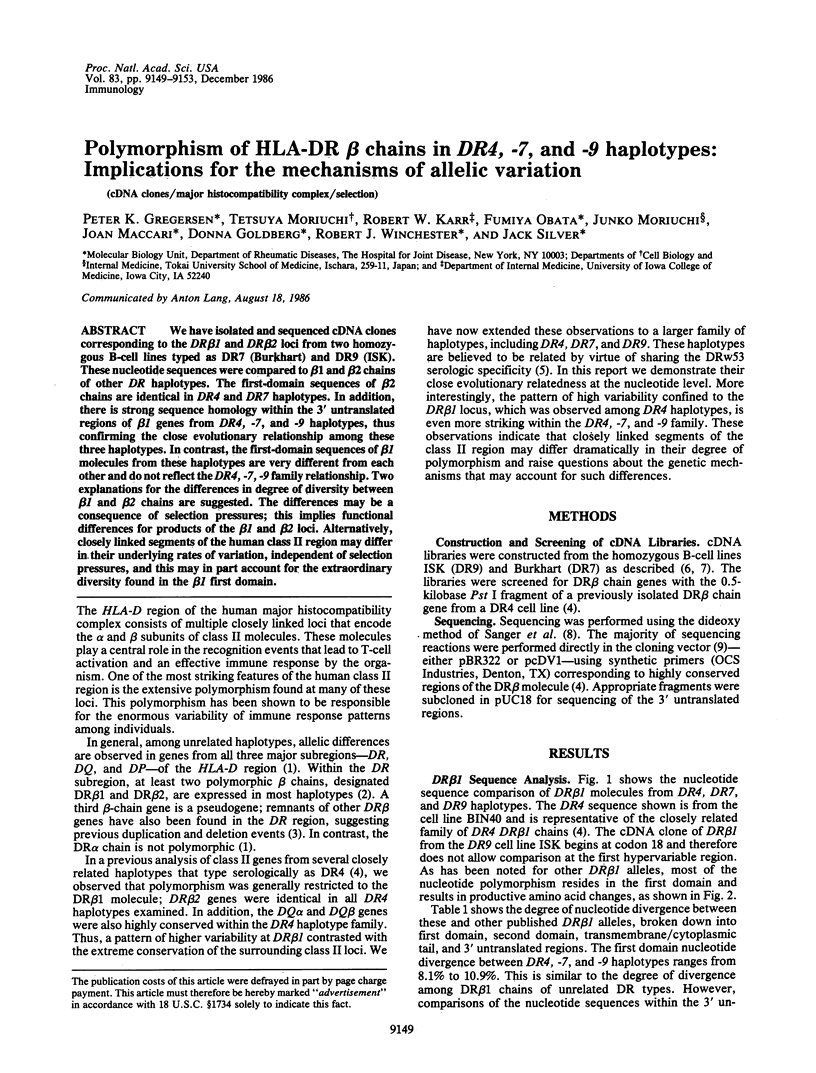
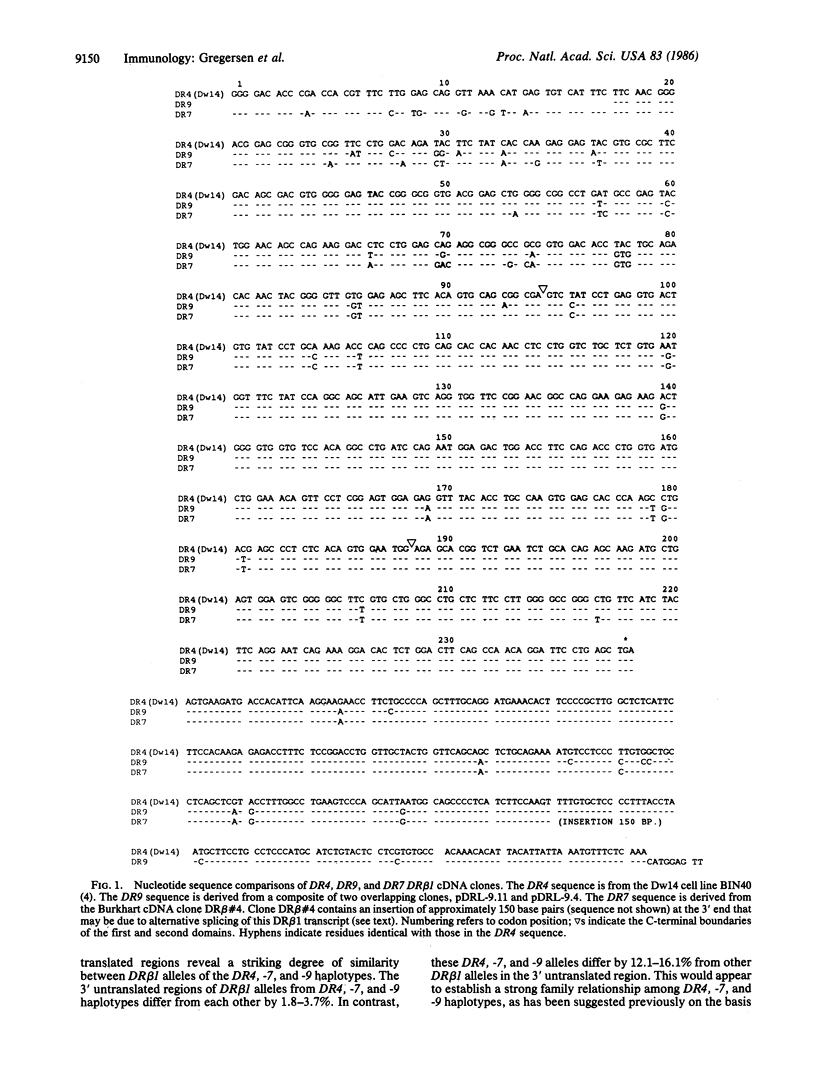
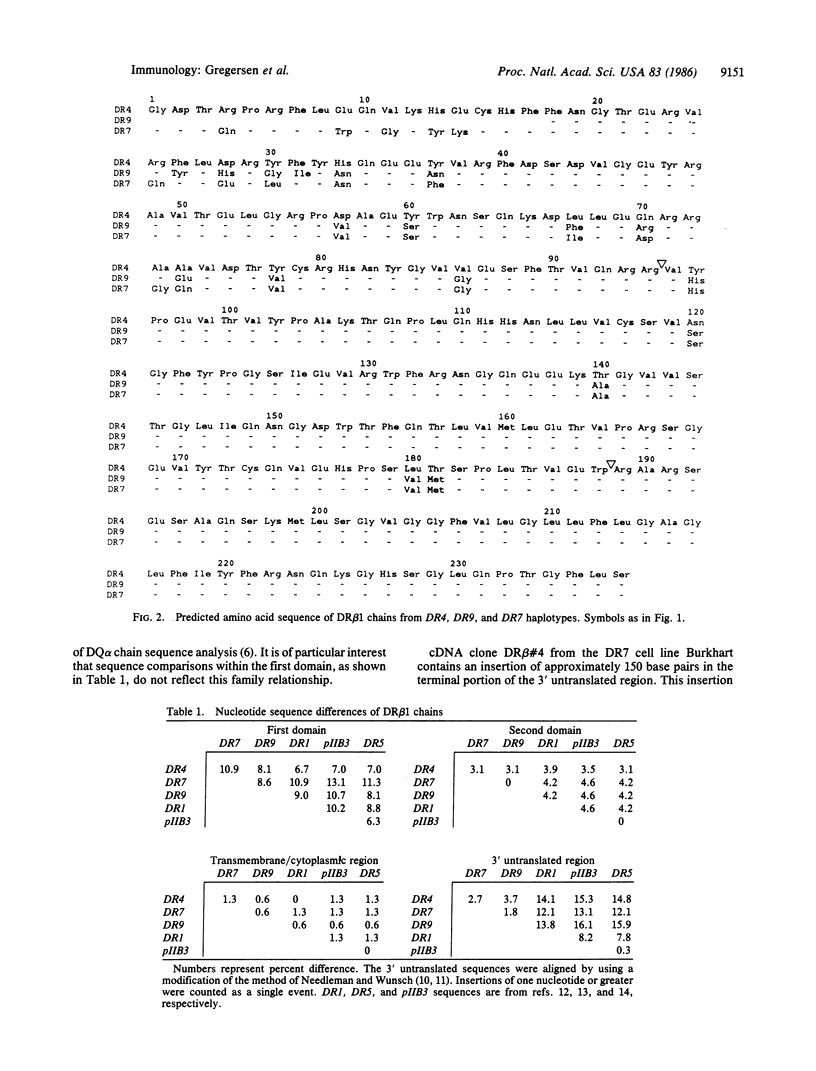
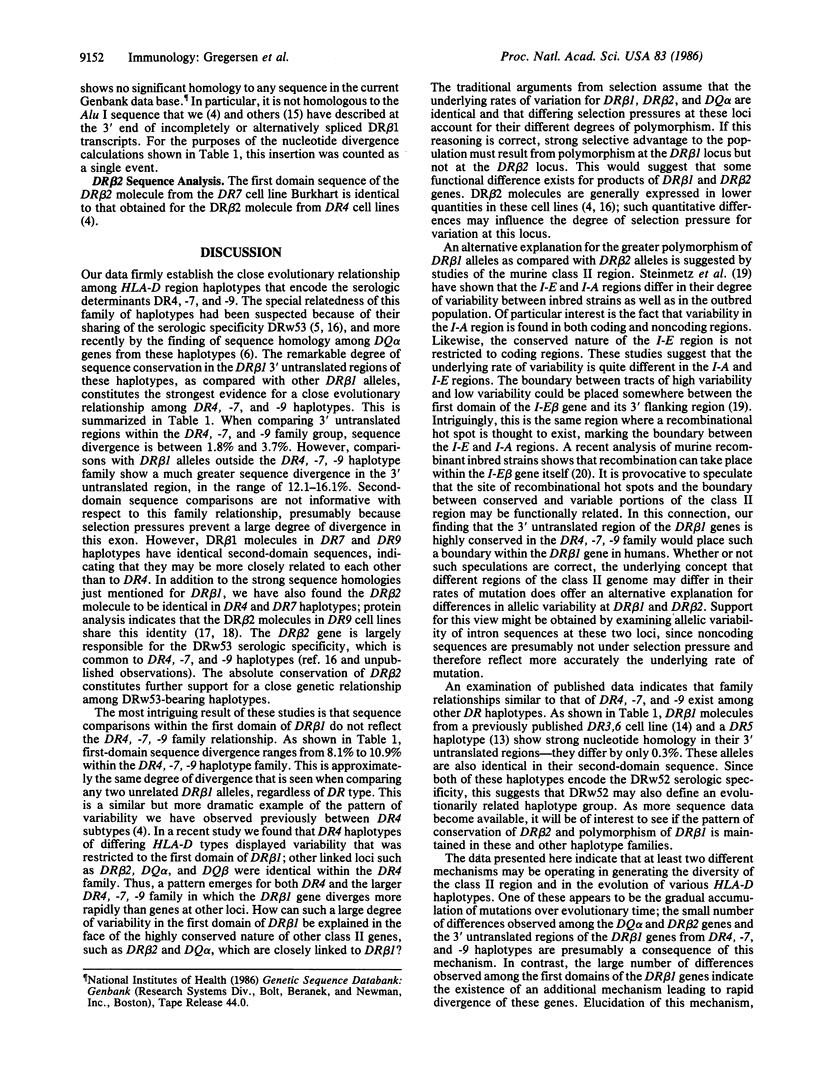
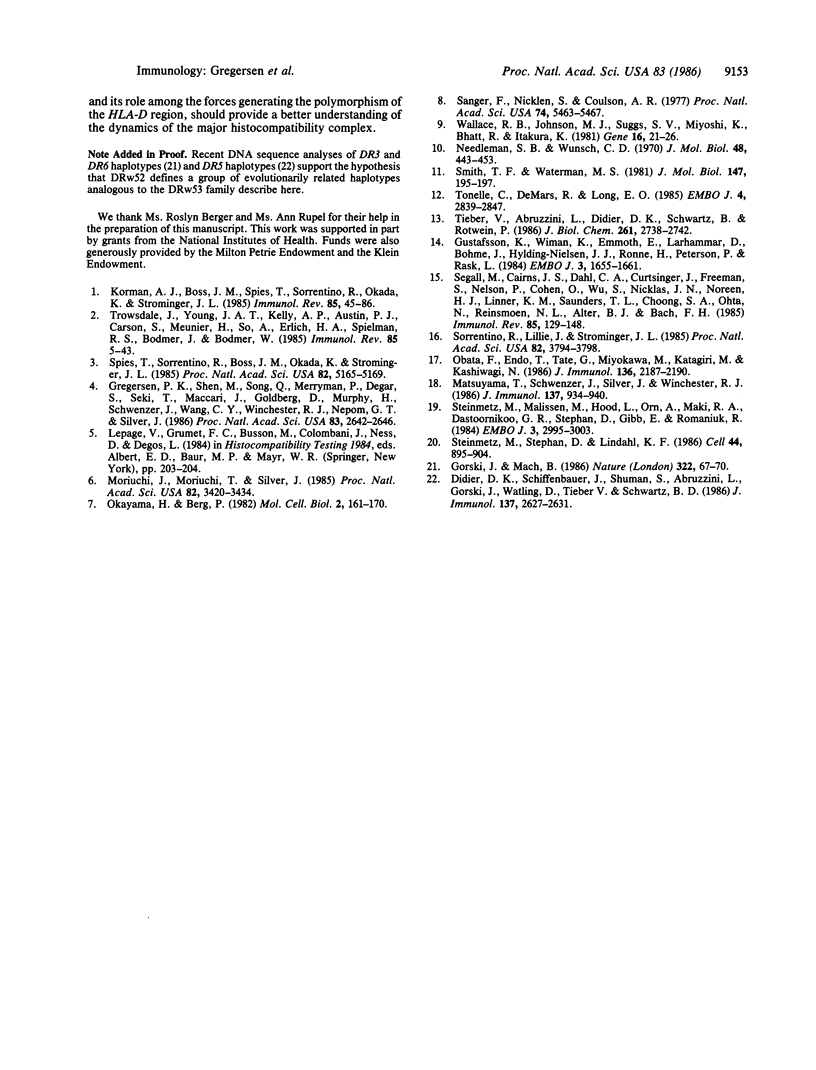
Selected References
These references are in PubMed. This may not be the complete list of references from this article.
- Didier D. K., Schiffenbauer J., Shuman S., Abruzzini L. F., Gorski J., Watling D. L., Tieber V. L., Schwartz B. D. Characterization of two distinct DR beta chain alleles at the beta III locus of the DR5 haplotype: beta III alleles are highly conserved. J Immunol. 1986 Oct 15;137(8):2627–2631. [PubMed] [Google Scholar]
- Gorski J., Mach B. Polymorphism of human Ia antigens: gene conversion between two DR beta loci results in a new HLA-D/DR specificity. Nature. 1986 Jul 3;322(6074):67–70. doi: 10.1038/322067a0. [DOI] [PubMed] [Google Scholar]
- Gregersen P. K., Shen M., Song Q. L., Merryman P., Degar S., Seki T., Maccari J., Goldberg D., Murphy H., Schwenzer J. Molecular diversity of HLA-DR4 haplotypes. Proc Natl Acad Sci U S A. 1986 Apr;83(8):2642–2646. doi: 10.1073/pnas.83.8.2642. [DOI] [PMC free article] [PubMed] [Google Scholar]
- Gustafsson K., Wiman K., Emmoth E., Larhammar D., Böhme J., Hyldig-Nielsen J. J., Ronne H., Peterson P. A., Rask L. Mutations and selection in the generation of class II histocompatibility antigen polymorphism. EMBO J. 1984 Jul;3(7):1655–1661. doi: 10.1002/j.1460-2075.1984.tb02026.x. [DOI] [PMC free article] [PubMed] [Google Scholar]
- Korman A. J., Boss J. M., Spies T., Sorrentino R., Okada K., Strominger J. L. Genetic complexity and expression of human class II histocompatibility antigens. Immunol Rev. 1985 Jul;85:45–86. doi: 10.1111/j.1600-065x.1985.tb01130.x. [DOI] [PubMed] [Google Scholar]
- Matsuyama T., Schwenzer J., Silver J., Winchester R. Structural relationships between the DR beta 1 and DR beta 2 subunits in DR4, 7, and w9 haplotypes and the DRw53 (MT3) specificity. J Immunol. 1986 Aug 1;137(3):934–940. [PubMed] [Google Scholar]
- Moriuchi J., Moriuchi T., Silver J. Nucleotide sequence of an HLA-DQ alpha chain derived from a DRw9 cell line: genetic and evolutionary implications. Proc Natl Acad Sci U S A. 1985 May;82(10):3420–3424. doi: 10.1073/pnas.82.10.3420. [DOI] [PMC free article] [PubMed] [Google Scholar]
- Needleman S. B., Wunsch C. D. A general method applicable to the search for similarities in the amino acid sequence of two proteins. J Mol Biol. 1970 Mar;48(3):443–453. doi: 10.1016/0022-2836(70)90057-4. [DOI] [PubMed] [Google Scholar]
- Obata F., Endo T., Tate G., Miyokawa N., Katagiri M., Kashiwagi N. Partial N-terminal sequence analysis of DRw53 antigens: the beta-chains of DRw53 antigens are structurally distinct from beta-chains of DR and DQ antigens. J Immunol. 1986 Mar 15;136(6):2187–2190. [PubMed] [Google Scholar]
- Okayama H., Berg P. High-efficiency cloning of full-length cDNA. Mol Cell Biol. 1982 Feb;2(2):161–170. doi: 10.1128/mcb.2.2.161. [DOI] [PMC free article] [PubMed] [Google Scholar]
- Sanger F., Nicklen S., Coulson A. R. DNA sequencing with chain-terminating inhibitors. Proc Natl Acad Sci U S A. 1977 Dec;74(12):5463–5467. doi: 10.1073/pnas.74.12.5463. [DOI] [PMC free article] [PubMed] [Google Scholar]
- Segall M., Cairns J. S., Dahl C. A., Curtsinger J. M., Freeman S., Nelson P. J., Cohen O., Wu S., Nicklas J. N., Noreen H. J. DNA and protein studies of HLA class II molecules: their relationship to T cell recognition. Immunol Rev. 1985 Jul;85:129–148. doi: 10.1111/j.1600-065x.1985.tb01133.x. [DOI] [PubMed] [Google Scholar]
- Smith T. F., Waterman M. S. Identification of common molecular subsequences. J Mol Biol. 1981 Mar 25;147(1):195–197. doi: 10.1016/0022-2836(81)90087-5. [DOI] [PubMed] [Google Scholar]
- Sorrentino R., Lillie J., Strominger J. L. Molecular characterization of MT3 antigens by two-dimensional gel electrophoresis, NH2-terminal amino acid sequence analysis, and southern blot analysis. Proc Natl Acad Sci U S A. 1985 Jun;82(11):3794–3798. doi: 10.1073/pnas.82.11.3794. [DOI] [PMC free article] [PubMed] [Google Scholar]
- Spies T., Sorrentino R., Boss J. M., Okada K., Strominger J. L. Structural organization of the DR subregion of the human major histocompatibility complex. Proc Natl Acad Sci U S A. 1985 Aug;82(15):5165–5169. doi: 10.1073/pnas.82.15.5165. [DOI] [PMC free article] [PubMed] [Google Scholar]
- Steinmetz M., Malissen M., Hood L., Orn A., Maki R. A., Dastoornikoo G. R., Stephan D., Gibb E., Romaniuk R. Tracts of high or low sequence divergence in the mouse major histocompatibility complex. EMBO J. 1984 Dec 1;3(12):2995–3003. doi: 10.1002/j.1460-2075.1984.tb02246.x. [DOI] [PMC free article] [PubMed] [Google Scholar]
- Steinmetz M., Stephan D., Fischer Lindahl K. Gene organization and recombinational hotspots in the murine major histocompatibility complex. Cell. 1986 Mar 28;44(6):895–904. doi: 10.1016/0092-8674(86)90012-7. [DOI] [PubMed] [Google Scholar]
- Tieber V. L., Abruzzini L. F., Didier D. K., Schwartz B. D., Rotwein P. Complete characterization and sequence of an HLA class II DR beta chain cDNA from the DR5 haplotype. J Biol Chem. 1986 Feb 25;261(6):2738–2742. [PubMed] [Google Scholar]
- Tonnelle C., DeMars R., Long E. O. DO beta: a new beta chain gene in HLA-D with a distinct regulation of expression. EMBO J. 1985 Nov;4(11):2839–2847. doi: 10.1002/j.1460-2075.1985.tb04012.x. [DOI] [PMC free article] [PubMed] [Google Scholar]
- Trowsdale J., Young J. A., Kelly A. P., Austin P. J., Carson S., Meunier H., So A., Erlich H. A., Spielman R. S., Bodmer J. Structure, sequence and polymorphism in the HLA-D region. Immunol Rev. 1985 Jul;85:5–43. doi: 10.1111/j.1600-065x.1985.tb01129.x. [DOI] [PubMed] [Google Scholar]
- Wallace R. B., Johnson M. J., Suggs S. V., Miyoshi K., Bhatt R., Itakura K. A set of synthetic oligodeoxyribonucleotide primers for DNA sequencing in the plasmid vector pBR322. Gene. 1981 Dec;16(1-3):21–26. doi: 10.1016/0378-1119(81)90057-3. [DOI] [PubMed] [Google Scholar]


